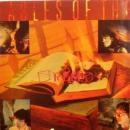I took a picture that I'll have to send
People here are friendly and content
People here are colorful and bright
The flowers often bloom at night
Amanita is the name
The flowers cover everything
The flowers cover everything
There's something here I find hard to ignore
There's something that I've never seen before
Amanita is the name they cover over everything
The flowers cover everything
They cover over everything (Amanita is the name)
The flowers cover everything
Don't look into the sun
Don't look into the sun
There's something that I've never seen before
The flowers often bloom at night
Amanita is the name they cover over everything.
People here are friendly and content
People here are colorful and bright
The flowers often bloom at night
Amanita is the name
The flowers cover everything
The flowers cover everything
There's something here I find hard to ignore
There's something that I've never seen before
Amanita is the name they cover over everything
The flowers cover everything
They cover over everything (Amanita is the name)
The flowers cover everything
Don't look into the sun
Don't look into the sun
There's something that I've never seen before
The flowers often bloom at night
Amanita is the name they cover over everything.
inviata da Riccardo Venturi
The Flowers of Guatemala
In a nutshell, the CIA overthrew a democratically-elected government because it was restricting U.S. corporate interests (The United Fruit Company) there. That happened in the 1950s under Eisenhower. Since then, the CIA has supported and planted a succession of military dictators in power. Those dictators and the military machines they upheld have slaughtered a total of 110,000 Guatemalan peasants over the years. All documented by human rights groups, though not (surprise, surprise) by the U.S. press. [bery]
"Amanita is the name"
Amanita is a scientific name, the genus of the most poisonous mushrooms in the world.
I remember that one species of Amanita (A. muscaria) is used to induce hallucinations, tho these visions stem from the delirium induced by the severe illness ingesting these things cause.
Amanita (muscaria) is the name.
"The flowers cover everything"
According to Stipe, the flowers on graves of the dead killed by the government. [Ron Henry]
http://www.flim.com/remlafaq/lrp/fog.html
In a nutshell, the CIA overthrew a democratically-elected government because it was restricting U.S. corporate interests (The United Fruit Company) there. That happened in the 1950s under Eisenhower. Since then, the CIA has supported and planted a succession of military dictators in power. Those dictators and the military machines they upheld have slaughtered a total of 110,000 Guatemalan peasants over the years. All documented by human rights groups, though not (surprise, surprise) by the U.S. press. [bery]
"Amanita is the name"
Amanita is a scientific name, the genus of the most poisonous mushrooms in the world.
I remember that one species of Amanita (A. muscaria) is used to induce hallucinations, tho these visions stem from the delirium induced by the severe illness ingesting these things cause.
Amanita (muscaria) is the name.
"The flowers cover everything"
According to Stipe, the flowers on graves of the dead killed by the government. [Ron Henry]
http://www.flim.com/remlafaq/lrp/fog.html
dq82 - 13/7/2015 - 15:29
I know he says that it's about Genocide, but there's nothing in the song itself to indicate that's anything other than an afterthought. The song is about mushrooms and people that look 'colorful', and seeing things that one hasn't seen before. Stipe can say the song is about genocide but with all due respect, based on the lyrics of the song, it is clearly about eating a mushroom.
Barty - 4/10/2016 - 19:30
The song was written right after the height of the genocide in Guatemala in 1981-1983 by the US-backed Guatemalan army. Quote by guitarist Peter Buck at the time of the album's release:“Forty people a week disappear in Guatemala. Why? Where do they go? Why do we support that?” About this song he said: “It doesn’t mention political oppression or the death squads, but I think it gets across.” (It Crawled From The South, An R.E.M. Companion - Marcus Gray)
Minder weergeven
Minder weergeven
Door - 5/12/2016 - 13:51
×
![]()








On a bootleg recording I have of a 1986 R.E.M. concert, singer Michael Stipe introduces "The Flowers of Guatemala" with a single word:"Genocide." In one of rock's most haunting songs, Stipe deploys Amanita, a flower that grows wild on graves, as a symbol for the catastrophe that descended on Guatemala's Mayan Indian population in the late 1970s and early 1980s. "There's something here I find hard to ignore," he sings, "there's something that I've never seen before." The song's chorus, with its incantation of "The flowers cover everything," is as evocative an expression of genocidal killing as any in popular music.
genocidetext.net